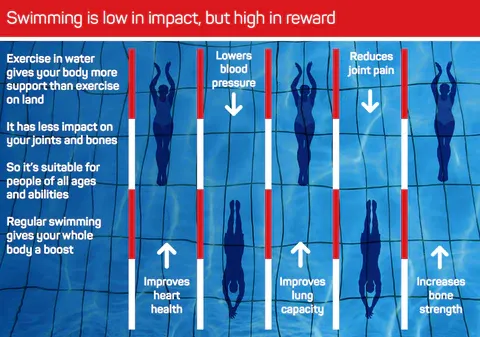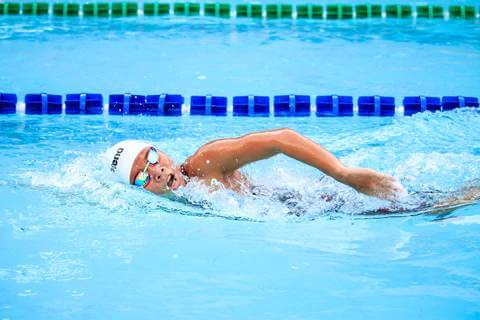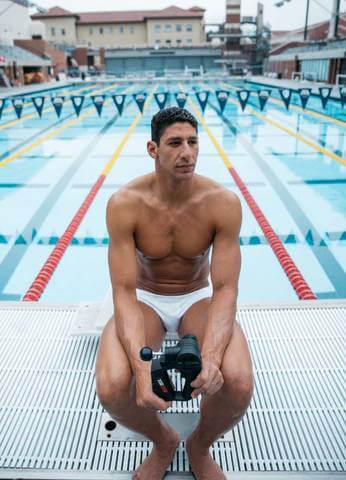The summertime brings a variety of new possibilities for your training. From moving your cardio to the trails at your favorite park to taking your ab routine to a grassy patch in the backyard, the summer has a way of making your workouts feel a little lighter. One of the greatest opportunities that summer presents? The chance to swim for training, enjoyment or recovery. At TimTam, we’re dedicated to keeping you in the look with the latest news and research for modern recovery, which is why we’re here to break down the incredible benefits of using swimming for your recovery. We’ll take a look at the physiological benefits of swimming, research in how swimming can aid in your recovery, and have even created a custom recovery plan using the Power Massager so you can take your summertime recovery to the next level.
Physiological Benefits of Swimming
Good for Your Body, Good for Your Recovery
 Image Source: https://myswimpro.com
Image Source: https://myswimpro.com
Even if you don’t identify as a swimmer, swimming has undeniable physiological benefits as both a recovery and training method. Swimming is a low-impact exercise that puts an extremely limited strain on your joints and muscles while the buoyancy of the water supports your body weight. Because of this, swimming is commonly used in rehabilitation for those suffering from back pain, torn ligaments, surgery, and developmental disorders.
Swimming is a unique exercise because it combines low impact exercise with high muscle engagement. Every stroke can both train muscles and alleviate pain in different ways, creating the perfect combination of active recovery, stretching, muscle movement, and engagement of hard-to-reach muscles. For example, backstroke is a great way to alleviate back pain because it requires an extremely low-impact stretch of back muscles while still engaging the muscles in motion with water resistance.
Not only is swimming great for your muscles, but the hydrostatic pressure helps circulate blood flow back to your heart, reducing heartbeats 10-15 beats per minute. This allows for both increased nutrient flow and waste productions. What does this mean for your recovery? Swimming is a great way to relax both your heart and your muscles after going all-in on a workout. The fact that cool to thermoneutral temperatures are the optimum range for recovery is just an added bonus.
Using Swimming as Active Recovery
A Study Showing the Benefits of Swimming on Performance

While the astounding benefits of swimming on the human body are known, researchers from around the globe wanted to put swimming to the test. Hoping to see that these benefits could boost performance, a group of researchers from the University of Western Australia conducted a test on nine well-training triathletes.
The participants performed an 8 x 3-minute interval run at 85-90% effort on two separate occasions. Ten hours after the run, the athletes either laid down or swam 2,000 meters. Fourteen hours later, the triathletes did a high-intensity run until fatigued to see if performance improved after the interval sessions.
The results of the study found that the 3,000-meter recovery swim resulted in a 14% time increase in the post-interval run. Subjects were able to run for 13 minutes and 50 seconds as opposed to 12 minutes and 8 seconds after simply lying down. Additionally, swimming reduced the level of c-reactive protein, which is a sign of muscle inflammation. These results suggest that swimming for recovery enhanced next-day performance by reducing muscle tissue inflammation from the first run.
Does Massage Help Make Swimming More Effective?
An additional study published in the Journal of Sports Medicine and Physical Fitness looked at the performance and levels of serum lactate remaining after swimming and using active recovery, massage, and passive recovery. The study found that active recovery - in continuing to swim a light workout as a warm-down - was the most effective method of clearing blood lactate, followed closely by massage. The study suggests that recovery swimming could universally apply to all athletes that experience inflammation upon exertion.l
As someone looking to make the most out of your recovery, this tells you that making the most out of your recovery involves mixing your methods. There are benefits to both active recovery and massage for recovery, so combining each for their individual benefits can result in the most well-rounded, complete recovery possible. How can you make this work for you? Luckily, TimTam has designed the perfect swimming and massage recovery plan.
The TimTam Swimming & Massage Recovery Plan
Try this Training and Recovery Plan for Optimum Performance

Image Courtesy of Azad Al-Barazi (@eza_surf on Instagram)
With swimming and massage both having spectacular benefits for recovery, we decided to combine swimming with a powerful massage from the TimTam Power Massager for the ultimate recovery plan. Let’s start with your warmup:
- Pre-workout: Use the Power Massager on your most valuable muscle areas. This helps with myofascial release so that you can feel loose, limber, and ready to tackle your workout. You’ll warm up your muscles while increasing blood flow to them for maximum performance while minimizing your likelihood of injury.
- Post-workout swim: Knowing that active recovery helps decrease your blood lactate levels faster than passive recovery or massage, we recommend a workout of approximately 12-16 laps (short distance pool, 400 meters total).
1 Lap - leg swings forward and backward, holding on to pool edge for support
2 Laps - jogging in water, using your arms to help propel yourself
2 Laps - high knees, taking your time and stretching out as necessary
2 Laps - butt kicks, taking your time and stretching out as necessary
Remaining (5-9) laps - slow in preferred stroke or kick
- Post-swim massage: After cool down, take time to rehydrate. After hydration, use the TimTam Power Massager on key muscle groups for 10-20 minutes. This will restore your fascia and increase blood supply to recovering muscles.
The undeniable benefits of swimming are something you have to try out for your summer recovery. Complement your recovery year-round with the TimTam Power Massager. Shop now or learn more about the Power Massager now.


